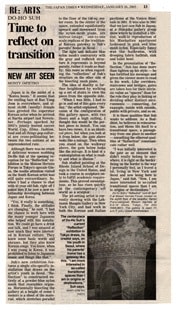
New Art Seen
Do-Ho Suh
Time to reflect on transition
By Monty DiPietro
Japan is in the midst of a "Korea boom." It seems that the smiling face of Bae Yong Joon is everywhere, and almost 10,000 (mostly) female fans greeted the superstar Korean actor when he arrived at Narita airport last November. Perhaps sparked by 2002's jointly hosted soccer World Cup, films, fashion, food and all things pop-cultural are cross-pollinating between the two nations at an unprecedented rate.
The centerpiece of Do-Ho Suh's current "Reflection" exhibition in Tokyo draws, its creator says, on his youth in Seoul, where his parents' home has a gateway like this. "I am more interested in so-called transitional spaces than I am in origins or destinations," Suh says.
Although there was no crush of delirious women mobbing Do-Ho Suh at the opening reception for his "Reflection" exhibition in the Maison Hermes Forum in Tokyo's upscale Ginza, the media attention visited on the South Korean artist was still quite extraordinary. So, when I had a chance to chat with 42-year-old Suh, right off I asked him if he saw a new relationship developing between Japan and Korea.
"Yes, it really is something, I think. Finally, the attitudes are changing," he said. "I had the chance to work here with the many younger Japanese who helped with this installation. We could go have a drink and talk, and I was amazed at how much they were interested in Korean culture. They knew some basic words and phrases, but they also knew Korean songs. You know, when I was young in Korea, it was prohibited to listen to Japanese music and things like that."
Suh's new exhibition features a single site-specific installation that draws on the artist's youth in Seoul. "Reflection" is constructed entirely of a powder-blue nylon mesh that resembles organza. Horizontally bisecting the gallery at a height of some 3 meters is a sheet of the material, which stretches parallel to the floor of the 140-sq.-meter room. In the center of the space, extended equidistantly upward and downward from the nylon-mesh plane, are mirror-image, one-to-one scale replicas of the traditional Korean gateway to Suh's parents' home in Seoul.
The light and delicate blue nylon mesh's contrariety with the gray and redbrick structure it represents is beyond parody, rather it reads as duality; this more so when regarding the "reflection" of Suh's structure on the other side of the bisecting mesh plane.
The idea of duality is further heightened by walking up a set of stairs to view the piece from the opposite side.
"When I was little, I had to go in and out of this gate every day," the artist explained. "Because of the configuration of this gallery space, with two floors and a high ceiling, I thought this would be the perfect piece to install. You can have two views; it is an identical piece, but when you look at it from below, the gate above looks like a mirage. Then when you stand on the walkway above, the gate below looks like the mirage. It is kind of a contemplation on what is reality and what is illusion."
Suh studied painting at the Rhode Island School of Design in the United States, and took a course in sculpture only to fulfill academic requirements. This proved serendipitous, as he has risen quickly in the contemporary art world as a sculptor.
The jet-setting artist is currently showing with the Lehmann Maupin Gallery in New York City, and had work in both the Korean and Italian pavilions at the Venice Biennale in 2001. It was also in 2001 that we last saw Suh in Japan, at a Shinjuku gallery group show where he installed a life-size, walk-in reproduction of his Manhattan apartment fashioned in pink and blue mesh nylon. Especially funny was the bathroom, with drooping fabric bathtub, sink and toilet bowl.
In the presentation of "Reflection," Suh has done more than tighten up his style -- he has fortified his message and given the viewer more to read in his work. Like corridors, staircases and bridges, gates are taken less for their intrinsic value as "spaces" than for the role they play in linking or dividing other distinct environments -- connecting, for example, inside with outside, public with private, and so on.
It is these qualities that Suh wants to address. As a Buddhist, he believes in reincarnation, and likens life itself to a transitional space, a passageway from one place to another -- something the ethereal qualities of "Reflection" communicate rather well.
"I was initially interested in the gate as an element that didn't really belong to anywhere, it is right on the border. Being on the border is the way I personally feel, as I travel a lot, living in New York and Seoul and now being here in Japan," said Suh. "Now, I am more interested in so-called transitional spaces than I am in origins or destinations."
Do-ho Suh's "Reflection" runs till April 3 at Maison Hermes Forum, located on the eighth floor of the beautiful, Renzo Piano-designed Maison Hermes at 5-4-19 Ginza, Tokyo. Tel (03) 3569-3611. The gallery is open 11 a.m.-7 p.m.; closed Wednesdays.
